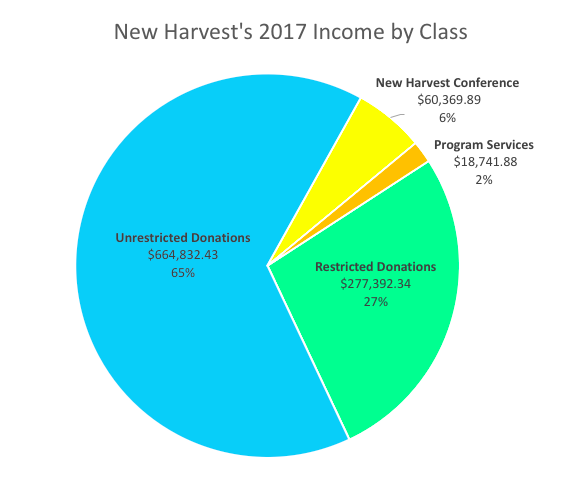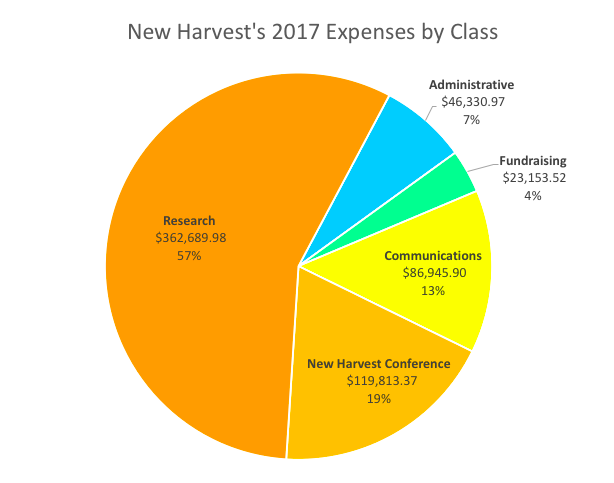This is the second year that New Harvest has categorized and shared the details of our expenses in a public forum (here’s last year’s financials).We care deeply about transparency in funding: not only does this help our donors understand where New Harvest earns and spends its money, it also keeps us proactively accountable.
The numbers presented below are all contributions and expenses attributed directly to New Harvest.
Income
In 2017, New Harvest’s primary source of income was unrestricted donations from 225+ members of our donor community.

The secondary source of income was restricted donations, primarily for the New Harvest Fellowship Program.
New Harvest also earned income from ticket sales and sponsorship for the New Harvest 2017 conference; as well as in program service fees for speaking and consulting engagements.
Expenses
We categorized our expenses into 5 categories for 2017.

Research is New Harvest’s largest expense. Expenses in this category include all grants given directly to funding academic research, plus the staffing and support (eg. retreats) required to manage our research effort. In 2017, $277,934 was given as grants for research, representing 77% of research program expenses. (By comparison, in 2016, $137,624 was given as grants, representing 67% of the research program expenses.)
The New Harvest Conference is our annual event to showcase cellular agriculture. Expenses in this category cover all logistics required to plan and run the event, such as venue bookings, staffing, catering, and printing.
Communications at New Harvest is an ongoing program, led by Communications Director Erin Kim. Expenses in this category include our generation of original content, outreach, and social media efforts, as well as any expenses incurred from New Harvest staff giving keynotes, lectures, and panel presentations to spread the word about cellular agriculture.
Administrative expenses are those incurred by the general operations of New Harvest as an organization.
Fundraising expenses are those incurred by any fundraising activity that New Harvest undertook throughout the year.
With a team of three full-time staff in 2017, every team member again found themselves working across multiple expense categories. As a result, payroll for each individual has been broken up by time commitment into the above five categories.
Reflections
A few points of note:
- We were able to grow our Research program (doubling our Research Fellows!) without increasing our overhead, Communications and Conference expenses. This is one piece of evidence confirming that our Fellowship program is scalable.
- The New Harvest 2017 conference cost $28,520 more than 2016, but earned $10,554 more in income. The cost increased because we expanded the conference from one day in 2016 to two days in 2017.
- New Harvest has begun receiving restricted donations for specific research projects. This indicates that New Harvest is maturing — we have piloted our Fellowship Program and are now ready to commit restricted funding to specific projects within it.
- New Harvest has begun a new income stream for speaking and consulting engagements that align with our mission.
- Research spending increased from 37% of New Harvest’s budget in 2016 to 57% in 2017.
- While the percentage spent on research grew, the percentages spent on administration (16% to 7%) and fundraising (13% to 4%) decreased. This is because of a change in staffing — at the end of 2016 we decided to close the Development Director position and hire a Research Director instead.
Here are a few things that we expect to be different in 2018:
- More restricted donations. We are expanding our Fellowship Program around specific projects which will be supported by specific donors.
- Increased income from Program Services. We expect to earn more from speaking and consulting engagements in the next year.
- Increased spending on research. We have budgeted to expand our research program in 2017.
For a more detailed picture of our 2017 financials, categorized by class and expense type, check out our audited Profit and Loss Report.
We’re most excited to see our Research program expand, and look forward to scaling the cellular agriculture scientific community in the years to come.
This could not have been done without out visionary donor community. Thank you for investing in science!


